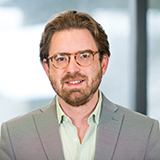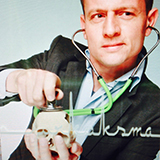Remember when you first heard that you had got into medical school? That great feeling of the dream coming true? How the happiness coincided with the sudden realization you would be given the responsibility to help the people who needed you? What happened to that dream once you started going to lectures with hundreds of other students? Perhaps the initial dream may have faded, because one crucial part of it was missing: the very people that students want to be a doctor for—the patients.
In the past occasionally, patients were wheeled in, prodded, and observed as “specimens” or examples of a particular disease, but during the first years of medical school, students rarely got a chance to meet the patient-as-a-person and hear their stories. This is now changing, and many medical school curricula have been redesigned to help students deliver person-centered healthcare [1]. The Radboudumc in the Netherlands is one such example. For three years now the Radboudumc has carried out a patient included curriculum, with patients and students as co-designers and actively participating partners.
We hope that we can align medical education with the current demands of medical practice, but can we also change practice by educating a new generation of practitioners? By humanizing medical education, we want to contribute to the transformation towards more person-centered care. Our ambition is to enable patients and students to learn as equal partners. Equity, for us, includes appreciating how we are different, but even more so focusing on what makes us the same.
When we designed our new curriculum, we involved patients (and students) right from the start and during every step of development. We based our entire process organization on the maxim “patients included” and had patient members involved in every committee (>10). We installed a Patient Advisory Board for Education (PAR-E) that managed the process of patient participation and whose members invited patients from their networks. Students from representative bodies of all undergraduate years formed a student community that provided for at least two students per committee.
On a few occasions teachers claimed that patient participation did not add anything or even hampered progress. This led to interesting discussions obliging teachers to rethink why they considered making progress as getting the job done as quickly as possible. Perhaps, at times, patients felt left out. Once, we found teachers having a lively discussion in the hospital restaurant in between meetings, while the patient on their committee was walking around not knowing where to go next. Talking about how to prevent such misunderstandings from happening was an incentive for taking perspective. Overall, it was a well-appreciated and productive model, with patients adding to the level of critical reflection and having an empowering effect on students.
In one of our projects, “Bring Your Own Patient” (BYOP), every single student in the first and second year (>660) teams up with a chronically ill patient for an entire year. The interaction is aimed at getting to know the person-behind-the-patient and help foster the motivation that students often start out with. Vice versa, patients get to know the students as people, and help students to develop the notion of the doctor that they really want to be. Students tell us BYOP makes them experience what it is like to live with a condition, see the relevance of establishing a relationship, and obtain a rich understanding of a patient’s personal context.
In BYOP, students meet patients at their homes, go shopping with them, join them during social activities and/or accompany them on their visits to caregivers. BYOP is linked to the “professionalization-track,” in which students reflect together and get personal guidance from both teachers and patient coaches. Students share how they have witnessed the discrepancies between doctors’ and patients’ perspectives and the need for building bridges; they feel they have grown professionally, mitigated anxieties, and boosted their confidence when it comes down to really “work with people”.
Finding space for new initiatives is difficult when teachers start to compete for programme time. Therefore it is crucial to appreciate how our new curriculum combines a patient participation approach with a didactic core centering around self directed learning (SDL). This means that what students actually learn has become more important than what you can squeeze into a curriculum on paper.
Patient participation is no add-on, it is the core. Next to BYOP we have another major type of practice based learning at the heart of the curriculum: “Student Meets Patient” which allows eight students to participate in a consultation in any one of our hospital’s departments, every week of their year. This means that after their first year students have already seen almost every department and met 40 different patients. Next, we have developed a patient centered eight month Health Innovation Project and several electives tased on the BYOP design [2, 3].
Studies suggest compassion may decline after medical school [4]. We call for a more educational focus on humane aspects, such as uniqueness, togetherness, sense-making, personal journey, sense of place, and embodiment [5]. However, just adding more complex concepts to a program’s attainment targets does not lead to humanization. What we need in medical education is culture change. BYOP provides an example of how to achieve this: by exposing the artificialities of classroom didactics, creating new learning spaces, and bringing education to life.
In the end, humanizing medical education centres around putting faith in humans. This goes down all the way to reconsidering what counts as relevant medical knowledge [6], and what constitutes quality of care: something we keep on learning together.
 Thomas Vijn is technical physician, patient, and PhD student in patient empowerment and person-centered care.
Thomas Vijn is technical physician, patient, and PhD student in patient empowerment and person-centered care.
 Jan Kremer is medical doctor and professor in patient-centered innovation.
Jan Kremer is medical doctor and professor in patient-centered innovation.
 Jur Koksma is learning researcher and philosopher.
Jur Koksma is learning researcher and philosopher.
Competing interests: None declared.
References:
- Frenk J, Chen L, Bhutta ZA, et al. Health professionals for a new century: transforming education to strengthen health systems in an interdependent world. Lancet. 2010;376(9756):1923-58.
- Koksma, J. J., van Woezik, T., van den Bosch, S., van den Bergh, C., Geerling, L., & Keunen, J. E. (2017). Learning to see things from a different perspective: interns and residents collaborate with artists to become better doctors. Nederlands tijdschrift voor geneeskunde, 161, D1840
- Vijn TW, Wollersheim H, Faber MJ, Fluit CRMG, Kremer JAM. Building a patient-centered and interprofessional training program with patients, students and care professionals: study protocol of a participatory design and evaluation study. BMC Health Serv Res. 2018;18(1):387.
- Neumann M, Edelhäuser F, Tauschel D, et al. Empathy decline and its reasons: a systematic review of studies with medical students and residents. Acad Med. 2011;86(8):996-1009.
- Todres L, Galvin, KT, Holloway I. The humanization of healthcare: A value framework for qualitative research. Int J Qual Stud Health Well-being. 2009;4(2):68-77.
- Carel H, Kidd IJ. Epistemic injustice in healthcare: a philosophical analysis. Med Health Care Philos. 2017;17(4):529-40.
